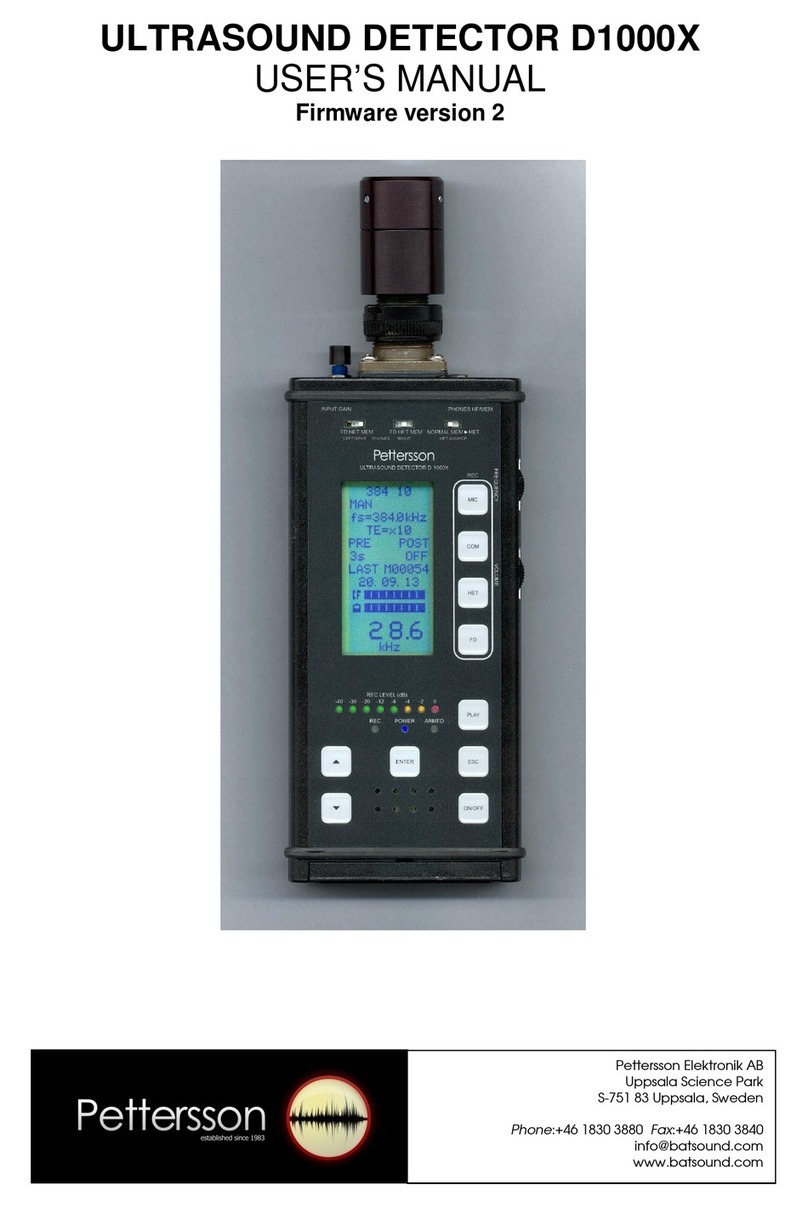THE TIME EXPANSION SYSTEM
This technique is similar to recording a sound on a tape recorder and then replaying the tape at a
reduced speed. However, in the D240x the signal is not stored on a magnetic tape but in a digital
memory. The time expansion principle is unique in the sense that it is the only ultrasound conversion
system that retains virtually all characteristics of the original signal, so time expanded signals are well
suited for many forms of advanced signal analysis (e.g. with our sound analysis software package
BatSound). A time expansion factor of either 10 or 20 can be selected with the switch located
immediately to the left of the relay output connector. The switch is accessible through the opening for
the relay connector. Using a small screwdriver or similar object is recommended to alter the switch
setting. The switch was given this sheltered position on purpose, to avoid inadvertently changing its
setting. The factory default setting is 10 (switch pointing towards the microphone).
There are two basic operation modes of the time expansion system, manual and automatic. The
operation mode is selected with the TRIG switch. In the manual mode, the MANUAL START/STOP
switch is used to start and stop storing the signal, while in the automatic mode, the detector captures
the signal itself when it exceeds an adjustable threshold level.
The maximum storage time in the time expansion system is 3.4 seconds. The actual memory size is
selected with the MEMory SIZE switch. The alternatives are: 3.4 sec, 1.7 sec and “MIN”. The default
factory value for “MIN”is 0.1 sec. On request, it is however also possible to obtain a “MIN” storage
time of 0.05 sec or 0.8 sec.
In order to obtain the highest sound quality on time expanded sounds, headphones should be used to
monitor the sounds. Listening to the heterodyne system through the speaker, while sampling a signal
to the time expansion system will cause the high frequency parts of the speaker sound to enter the
microphone and to be mixed with the desired ultrasonic signal.
When the D240X is switched on, the memory of the detector is filled with a random signal which may
sound like white noise. After switching the detector on, please allow at least the chosen memory time
(e.g. 3.4 seconds) to elapse before you interrupt the recording by pressing the MANUAL
START/STOP button (or, in the AUTO mode, the recording is interrupted by an incoming sound) and
this random signal will be replaced with a “real” signal. If you change the memory time, please first
make a new recording and allow the entire memory to be filled, as described above.
The manual triggering mode
To select the manual triggering mode, set the TRIG switch to the MAN position.
The MANUAL START/STOP switch is used to start and stop the sampling into the digital memory of
the time expansion system in the manual operation mode. The red LED below the frequency display
indicates the recording status (light on = ”recording”, light off = ”replaying”). When the detector is in
the ”record” mode, samples are continuously stored into the memory (when the memory is full the
samples that were first stored are overwritten, so at each time, the memory contains the last 3.4/1.7/0.1
seconds of the signal). Pushing the push-button to switch to the ”replay” mode, will cause the content
of the memory to be replayed in an endless loop fashion. This is done at 1/10 (1/20) of the original
rate, so one sequence lasts for 34/17/1 (68/34/2) seconds.
The automatic triggering mode
To select the automatic triggering mode, set the TRIG switch to the AUTO position. In this mode, the
detector will capture the signal itself and store it in the time expansion memory.


























